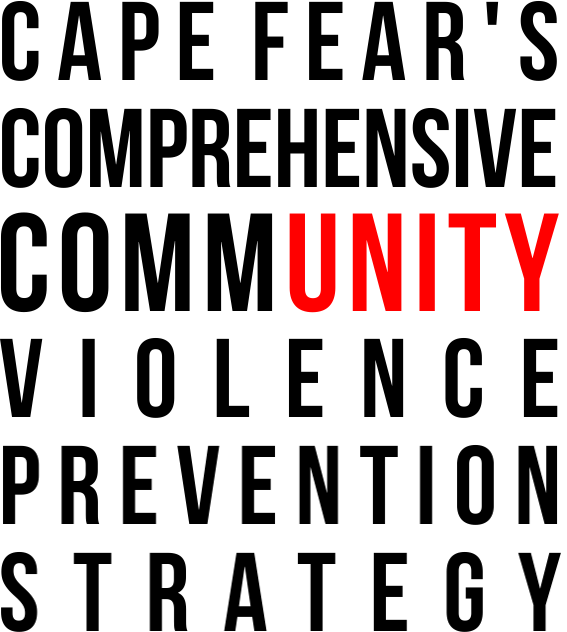The Problem
Violence
Violence is a leading cause of injury and death among marginalized communities. It has also been connected to poor health outcomes such as depression, anxiety, and diabetes, as well as high-risk behaviors such as drug and alcohol abuse and unhealthy intimate relationships. We know that communities of color are disproportionately impacted by violence, and among the many social determinants of health, violence has been identified as a primary driver of unfavorable health outcomes.
Decades of comprehensive research has established that multiple forms of violence intersect with each other, and exhibit shared risk and protective factors.
Wilmington, North Carolina's unique history, coupled with its current socioeconomic and political dynamic, cultivates and breeds an unacknowledged level of toxic insecurity that is perpetuated via laws, social norms, and regulations that diminishes opportunities for historically marginalized populations. Racism and its systemic capacity to justify and execute discretionary treatment of individuals of color continues to infiltrate the daily life of the citizens of Wilmington and its surrounding areas.
A Public Health Crisis
Racism has been declared a "public health crisis" because it continues to undermine the quality and longevity of human life in environments where it remains persistent in the lives of historically marginalized populations, as it has here in Wilmington. Within the multiple forms of violence, "racially motivated structural violence" encompasses two key forms that epitomize the reason we witnessed the declaration from our New Hanover County Commissioners.
New Hanover County Commissioners declaration:
WHEREAS, the New Hanover County Board of Commissioners has identified the reduction of Racial inequity as a critical priority and essential to effective and systemic delivery of health and human services in New Hanover County...
The County Commissioners continue,
WHEREAS, the American Academy of Pediatrics states Racism is a socially transmitted disease passed down through generations, leading to the inequities observed in our population today... Racism has produced and perpetuates poverty through intentional and unintentional policies that create barriers to economic mobility; and is a social system with multiple dimensions: individual Racism that is internalized or interpersonal, and systemic Racism that is institutional or structural...
View the full resolution [PDF]
A Call to Action
On August 18, 2020, Wilmington City Council announced a call to action titled Rise Together Initiative, in which they outlined not only the city's traumatic past but also their proposed stance and support of creating a better future for Wilmington.
Wilmington City Council statement:
...institutions and events like slavery, the 1898 Wilmington Massacre, racial segregation, and the Wilmington Ten prosecutions cast a long shadow in our city's history... and within the 1898 Wilmington Race Riot Commission's Report, published in 2006, it was ... found that the organizers of the overthrow took part in a documented conspiracy; the leaders, who were members of the Democratic white elite in Wilmington and New Hanover County, achieved their political goals through violence and intimidation... They acknowledge... the residual challenges stemming from episodes of such great magnitude as these are still felt today in ways that go both noticed and unnoticed by many in our community.
View a copy of the call to action [PDF]
Statistical Data
The inequity is further illustrated by statistical data published by the Cape Fear Collective Racial Equity Dashboard.
- Income: 65% of households have an annual income less than the Wilmington median of $45,000.
- Arrests: Between the years 2011 to 2018, the percentage of all arrest charges associated with a Black suspect rose from 47% to 50%. Meanwhile, the percentage of Wilmington's population that is Black has decreased from 21% to 19%.
- Incidents: Between the years 2011 to 2017, the percentage of all incident charges associated with a Black suspect rose from 39% to 52%. Meanwhile, the percentage of Wilmington's population that is Black has decreased from 21% to 19%. (It should be noted that Wilmington's African American population is only 17.83 % of the overall city demographics).
Get more info at the Cape Fear Collective Racial Equity Dashboard
The Initiative
We intend to implement an adaptation of a proven, evidence-based initiative titled STRYVE (Striving to Reduce Youth Violence Everywhere), originally introduced by the Centers for Disease Control & Prevention (CDC) and executed by the Multnomah County Health Department (MCHD).
Our approach is a very subtle, yet significant shift in the 2011-2016 MCHD STRYVE model. Whereas the STRYVE initiative in consisted of Health Department staff and executive personnel leading and then engaging multiple professional disciplines and community stakeholders in educating and collaborating in the implementation of violence prevention strategies, we intend to execute this model utilizing existing community leadership and infrastructure as the primary developers and drivers.
STRYVE, beginning in 2011 ending in 2016, was a national youth violence prevention program consisting of 4 demonstration sites: Salinas, CA; Houston, TX; Boston, MA; and Portland, OR. This model consists of a 5 year timeline: a 2 year planning period and a 3 year implementation of two evidence-based curricula. In addition to the two evidence-based curricula, MCHD emphasized the role of Community Health Workers (CHW), with the primary focus on violence prevention and community-based participatory research. Our program will be based on Portland Oregon's model as implemented by the Multnomah County Health Department, with the key difference noted above.
STRYVE Brochure [PDF]
STRYVE Final Evaluation Report [PDF]
Implementation Strategies
Youth Empowerment Solution (YES)
A nationally recognized, evidence-based curriculum
"YES is an evidence-based program that empowers youth to make positive changes in their communities and to work with adults to support their efforts. The goals of the YES program are to provide youth with opportunities for meaningful involvement in preventing youth violence and creating community change, to enhance the ability of adults to support youth in an empowerment framework, and to change the social and physical environment to reduce and prevent violence (especially youth violence)."
Learn more about the YES program
Crime Prevention Through Environmental Design (CPTED)
A nationally recognized, evidence-based curriculum
Community Health Worker (CHW)
As a key role in violence prevention
"A Community Health Worker (CHW) is a frontline public health worker who is a trusted member of and/or has an unusually close understanding of the community served. This trusting relationship enables the worker to serve as a liaison/link/intermediary between health/social services and the community to facilitate access to services and improve the quality and cultural competence of service delivery. A community health worker also builds individual and community capacity by increasing health knowledge and self-sufficiency through a range of activities such as outreach, community education, informal counseling, social support, and advocacy."
Learn more about Community Health Workers
Community-Based Participatory Research (CBPR)
"An approach to research that involves collective, reflective, and systemic inquiry in which researchers and community stakeholders engage as equal partners in all steps of the research process with the goals of educating, improving practice, or bringing about social change."
See an example of Community Based Participatory Research
Community Healing Initiative (CHI)
A health promotion campaign that facilitates increased understanding and supports a shift to behavioral norms that emphasize the healing of generational trauma and mitigates the negative effects of toxic stress.
See an example of a Community Healing Initiative
The Outcomes
Per the STRYVE model, we will create a Multi-Sector Stakeholders Coalition whose purpose will be to engage in a collaborative process to define our priorities, identify expected outcomes, and create a timeline of implementation.
As a baseline, our initiative will seek to establish and measure community cohesion and collective efficacy.
Cape Fear's Comprehensive CommUnity Violence Prevention Strategy will focus on preventing and mitigating the negative impacts of structural violence and community violence (refer to Understanding Violence Typology in the Appendix section.)
Principle Coordinators
Quality Life Blueprint (QLB)
A community-based institute of learning, collaboration, and capacity building, with a focus on responding to the needs of the most vulnerable populations in America.
qualitylifeblueprint.org
Advance Youth Outreach (AYO)
An organization dedicated to reducing negative behavior by equipping our youth with resources and opportunities, and to educate our youth to come up with community solutions.
advanceyouthoutreach.org
Lily Nicole Nichelle - Consultant (LNNC)
Using art and culture to support and empower individuals and communities to advocate and facilitate transformation within their personal and collective lives.
lilynicole.art
Contributors and Consultants
Please refer to page 6 of the full proposal document [PDF] for a list of content contributors and professional consultants.
Appendix: Understanding Violence Typology
Multnomah County Health Department Community Capacitation Center: Understanding Violence Typology (adaptation)
- War: This includes officially state-sanctioned acts of war, all methods of war for controlling populations, including sexual violence and abductions, military coups, and violent revolutions, as well as secret acts of violence perpetrated by governments and anti-government forces, even when unofficially acknowledged.
- Structural Violence: "Structural violence is one way of describing social arrangements that put individuals and populations in harm's way... The arrangements are structural because they are embedded in the political and economic organization of our social world; they are violent because they cause injury to people ... neither culture nor pure individual will is at fault; rather, historically given (and often economically driven) processes and forces conspire to constrain individual agency. Structural violence is visited upon all those whose social status denies them access to the fruits of scientific and social progress." Paul Farmer- Pathologies of Power
Examples of structural violence include unregulated police violence, racial profiling, gentrification, environmental racism, patriarchal structures, lack of accessible institutions for people with disabilities, abuse of disabled people by professional caregivers, poor treatment of POC in the hospital sytem, forced sterilization of women of color and women in general, normalization of violence portrayed by the media against marginalized groups, and numerous inequitable policies between high income communites in contrast to low income communites.
- Community Violence: This includes violence that surrounds us in the community. It includes police violence, gang violence, sexual violence that is not inter-personal violence and violence associated with human trafficking. Examples include date rape, workplace harrassment, and assault that happens outside your home or safe space.
- Domestic Violence: This includes all forms of domestic violence that are laid out in the Children's Exposure to Violence Training such as physical abuse, sexual abuse, emotional abuse, verbal abuse, identity abuse, financial abuse, or spiritual abuse between partners or directed at children or elders, if they are family members. It involves a trusted person or level of familiarity and typically occurs in your safe space or in a trusted location, regardless of permanent address.
- Self-Inflicted Violence: where an individual commits acts of violence against their own body, such as self abuse and suicide. Self-inflicted violence can occur as a result of the accumulated trauma from any of the above types of violence or any combination of the above types of violence. Trauma can be the product of the cumulative and co-occurring impact of regular incidents of interpersonal violence, oppression, isolation, historical and intergenerational violence, and continual exposure.
- Sexual Violence: Sexual violence is sexual activity when consent in not obtained or not freely given. Sexual violence impacts every community and affects people of all genders, sexual orientations, and ages. Anyone can experience or perpetrate sexual violence.
The perpetrator of sexual violence is usually someone known to the victim, such as a friend, current or former intimate partner, coworker, neighbor, or even family member.
- Ideology Based Violence: This includes acts of violence based on one person's or group's belief system or hatred of another type of person or their beliefs. This includes violence against different religious groups, against people based on gender identity, sexual orientation, race/ethnicity, ability status, immigration status, etc.
Examples include violence against trans-people of all ethnicities, lynchings, honor killings, ritual violence, mosque/church/temple burnings, clinic bombings, gay bashing, etc.




